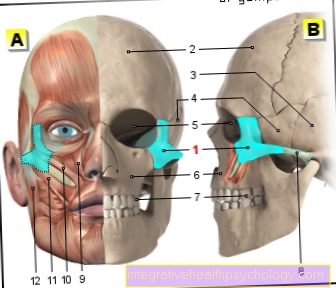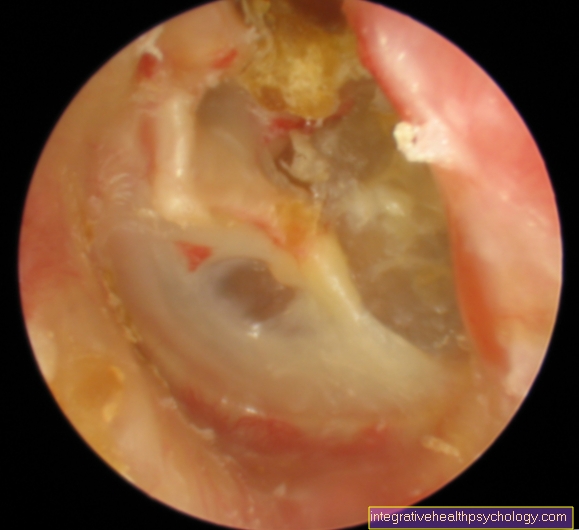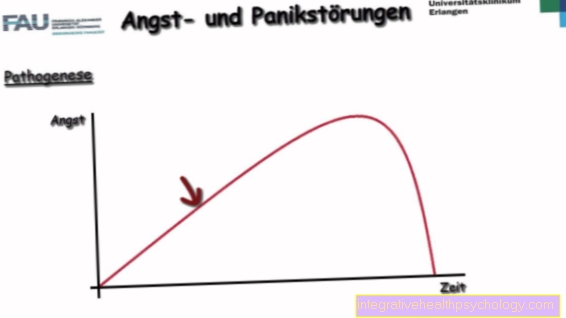Pain behind the eye
introduction
Headaches are one of the most common clinical pictures in everyday practice. Chronic headaches are also common among the population. The pain can be in very different regions of the head. The pain often pulls behind one or both eyes, sometimes it is less pulling than localized.

Pain as the leading symptom
Pain behind the eye can have several causes. Often it is a tension headache or an incorrectly set number of diopters on the glasses. However, tumors can also cause pain in rare cases.
Depending on how the pain is characterized (stabbing, pressing, etc.) and where it occurs, various clinical pictures can be narrowed down.
For eye socket pain, you can find more information here: Pain in the eye socket - what is the cause?
Throbbing pain behind the eye
Pain behind the eye that is throbbing is mostly caused by the very common migraines. The exact reason why this throbbing painful phenomenon occurs has not yet been fully clarified. It is often the case that side effects such as nausea or sensitivity to light also accompany the pain behind the eye.
A migraine attack can occur suddenly or a few hours beforehand through the so-called aura. Aura is used to describe neurological phenomena such as visual disturbances or an indescribable, uncomfortable feeling. The visual disturbances are characterized by rapidly rotating lightning bolts that can severely restrict the field of vision. As soon as the visual disturbances disappear, the headache located behind the eye begins. The pulse-synchronous character is often typical of a migraine headache behind the eye. The pain, which is very strong, does not allow the patient to move quickly, as the pounding pain behind the eye increases with the pulse rate.
Also read the article: The sensitivity of the eye to light.
Pressing pain behind the eye

There is seldom an oppressive, stationary pain behind the eye during a migraine attack. Sometimes a severe tension headache that is actually localized in the forehead area can also pull behind one or both eyes. In the case of pain behind the eyes that occurs suddenly and has not disappeared after a few days, you should definitely rule out a tumor. Tumors can form behind the eye and thus lead to increased pressure on the eyeball with its nerves, which can lead to stationary pain. The examination is done by imaging with the help of a CT (computed tomography) or MRI (magnetic resonance tomography).
Pain when moving eyes
Sharp or pressing pain that occurs when moving the eye by focusing (focusing) is very common and has no disease value. Mostly in connection with a flu-like infection, pain behind the eye when moving the eyes is reported.
A more detailed examination should only be carried out if the symptoms have not disappeared after a few days. An MRI or CT would be used for "maximum diagnostics".
Treatment of such eye pain can be done with conventional Painkillers and anti-inflammatory drugs, like Ibuprofen or Diclofenac be performed.
Pain behind both eyes
Pain that occurs suddenly or slowly behind both eyes at the same time can also always have something to do with changing eyesight. If the eyes get worse and the required number of diopters of the glasses increases, the eye has to work harder to reproduce the focused image just as sharply. In any case, an eye test should be carried out here, because the pain problem behind the eye is often already resolved by strengthening the necessary glasses.
Headache behind the eye when moving

If headache behind the eye is mainly caused by moving the head, it is likely a muscular cause. Either it is the eye muscles that are heavily used during the turning movement (especially if the eye only fixes one point when the head is turning), or it is a muscular tension of the neck or face muscles that transmits the pain stimulus behind the eye.
If pain behind the eye only occurs when the head is moved and no pain is triggered when the patient is at rest, a tumor behind the eye is unlikely to be the cause. A tumor can be attached to an eye muscle in such a way that it only triggers painful pressure when the eye is moved, but in this case imaging with an MRI or CT should not be performed immediately, but only if the pain does not disappear after a few days get better or even worse.
Pain behind both eyes and forehead
Pain behind the eye, which occurs in connection with pain in the forehead, is in the vast majority of cases harmless and should only be clarified more precisely if the pain has not improved after a few days.
In most cases it is Tension headachewhich e.g. caused by stress or not enough drinking and which, starting from the forehead, are conducted by nerves behind the eyes. The treatment should be a anti-inflammatory pain therapy started and the water balance checked.
Sometimes the cause of pain behind the eye and forehead can be due to a vascular cause. With a so-called Sinus vein thrombosis it comes to one Blood clots (see also: thrombosis) in one or more blood vessels supplying the Gehrin. The formation usually goes unnoticed and only becomes symptomatic when the pain is drawn from the forehead into the eyes. This provides the first indications for a sinus vein thrombosis Blood count with contained therein increased D-dimers. A MRI angiography then often shows the blood clot in the area of the sinus (blood vessel of the brain).
Pain behind the eye and in the neck
The combination of pain behind the eye and in the neck are very common and often due to Tension. The neck muscles, which are located in the area of the upper parts of the spine, are very strong and also sensitive.
Psychological tension often leads to tension in the neck muscles. This is then very painful to pressure locally on the neck and can also radiate into other regions. In addition to radiating into the forehead, arms and chest, the pain can also drag behind one or both eyes.
As a rule, however, the pain cannot be triggered by eye movements.
Those affected complain of pain behind the eye, but can usually locate the starting point of the pain in the neck area. Sometimes the neck and combined eye pain can also be from Visual disturbances be accompanied. Next anti-inflammatory and pain reliever drugs Sometimes one also helps Heat treatment with a hot water bottle that is placed on the neck.
If that doesn't help and neck and eye pain keep recurring, it should also be considered once X-ray of the cervical spine perform. Signs of wear and tear on the vertebral bodies that have developed over the years can be seen and displayed in this way.
However, it must be said that treatment in the case of vertebral body changes caused by wear is not possible. The most successful treatment of such complaints can most likely be done by exercising the muscles that stretch on the sides of the vertebral bodies. This is going through physical therapy made possible, which the family doctor or orthopedist can prescribe for those affected. As a rule, a corresponding training of the muscles next to the vertebral bodies of the cervical spine is carried out 2-3 times for 3 weeks using ligaments and weights, which relieves the cervical spine accordingly.
Treatment with analgesic injections can also be carried out. With the also as Wheals A pain reliever is injected just under the skin over the muscles of the cervical spine. The effect takes place relatively quickly. Unfortunately, the drug is also quickly drained from the body, which then leads to a renewed increase in pain.
In many general practices there is also one Treatment with electrical stimulation offered. In this form of treatment, a current is sent through the muscles on the sides of the cervical spine. The application only takes a few minutes and should be perceived by the patient as a pleasant tingling sensation. It is most effective to use it for about a week. Current stimulation treatments are usually also covered by statutory health insurance.
Any patient who reports pain in the neck and eye should also refer to one Meningism (Inflammation of the meninges) to be examined. With a simple test (strong bending of the head towards the chest), you can find out whether the cause is possibly meningitis. With meningitis, the patient would not be able to rest their head on their chest.
You can also read our article on this Pain in the neck
Pain behind the eye from a tumor
The most dreaded cause of pain behind the eye is the eye tumor. Compared to other cancers, a tumor behind the eye is relatively rare. It can be benign or malignant in origin.
In addition to pain, which it can usually trigger behind the eye at rest and while moving, it mainly causes pain through the one it causes increasing pressure on the eye Complaints. The tumor on the eye can ultimately appear in any position. Often times it occurs behind the eye or even behind the retina on.
In addition to the malignancy, a special feature of the treatment is also the location. Because some tumors, even if they are of benign origin, are very difficult to access surgically. In that case you try them through Irradiation to downsize first before approaching them operationally. Some tumors are so unfavorable that surgical intervention would endanger the optic nerve and thus the visual light.
Benign tumors can be left and hoped that they will not enlarge. A growing tumor has to be surgically removed sooner or later, at the risk of damaging the eye.
In some cases the only option is a complete operational one Eye removal. In addition to the pain behind the eye that is sometimes triggered, there are often Visual disturbances perceived as the first symptom by the patient. Some eye tumors can also be carried out directly by an ophthalmologist Ophthalmoscopy be seen. The most common eye tumors are Retinoblastoma in children (18,000-20,000 newborns and around 60 children per year), as well as in adults Choroidal melanoma (malignant tumor that arises from certain cells in the choroid in the eye). Mostly, visual disturbances are also mentioned here by those affected. Some tumors grow so large that they put pressure on one or more eye muscles. As a result, the affected eye can no longer be moved in the usual way. There is a deviation of the axis of the eye and a Squinting or looking away.
If an eye tumor is suspected, an imaging of the head should be performed. Here comes the MRI Investigation to use. It takes about 15-20 minutes and is usually done with one Contrast media and makes possible tumors in the area of the eye visible.
Please also read our article on this Retinoblastoma - tumor of the skin of the mink





























